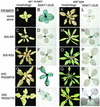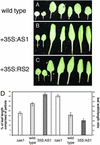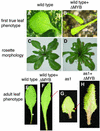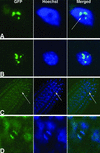Conservation and molecular dissection of ROUGH SHEATH2 and ASYMMETRIC LEAVES1 function in leaf development
- PMID: 12750468
- PMCID: PMC164533
- DOI: 10.1073/pnas.1132113100
Conservation and molecular dissection of ROUGH SHEATH2 and ASYMMETRIC LEAVES1 function in leaf development
Abstract
Maize ROUGH SHEATH2 (RS2) and Arabidopsis ASYMMETRIC LEAVES1 (AS1) are orthologous Myb-related genes required for leaf development and act as negative regulators of class 1 KNOTTED1-like homeobox (KNOX) genes in leaf primordia. Expression of RS2 in Arabidopsis fully complements as1 leaf phenotypes and represses the expression of the KNOX gene KNAT1 in leaves. Whereas loss of AS1 function in Arabidopsis results in rounded, lobed leaves with shorter and wider petioles, overexpression of either RS2 or AS1 results in longer and narrower leaves with longer petioles than wild type. A conserved C-terminal domain (CTD) mediates homodimerization of both RS2 and AS1 and modulates leaf shape when expressed independently of the Myb domain in Arabidopsis. Homodimerization is not absolutely required for KNAT1 repression. RS2:GFP fusion protein is biologically active, localized in discrete dynamic subnuclear foci and associates with DNA during cell division.
Figures






References
-
- Waites, R., Selvadurai, H. R. N., Oliver, I. R. & Hudson, A. (1998) Cell 93, 779-789. - PubMed
-
- Schneeberger, R., Tsiantis, M., Freeling, M. & Langdale, J. A. (1998) Development (Cambridge, U.K.) 125, 2857-2865. - PubMed
-
- Timmermans, M. C. P., Hudson, A., Becraft, P. W. & Nelson, T. (1999) Science 284, 151-153. - PubMed
-
- Tsiantis, M., Schneeberger, R., Golz, J. F., Freeling, M. & Langdale, J. A. (1999) Science 284, 154-156. - PubMed
-
- Byrne, M. E., Barley, R., Curtis, M., Arroyo, J. M., Dunham, M., Hudson, A. & Martienssen, R. A. (2000) Nature 408, 967-971. - PubMed
MeSH terms
Substances
LinkOut - more resources
Full Text Sources
Other Literature Sources
Molecular Biology Databases
Research Materials

